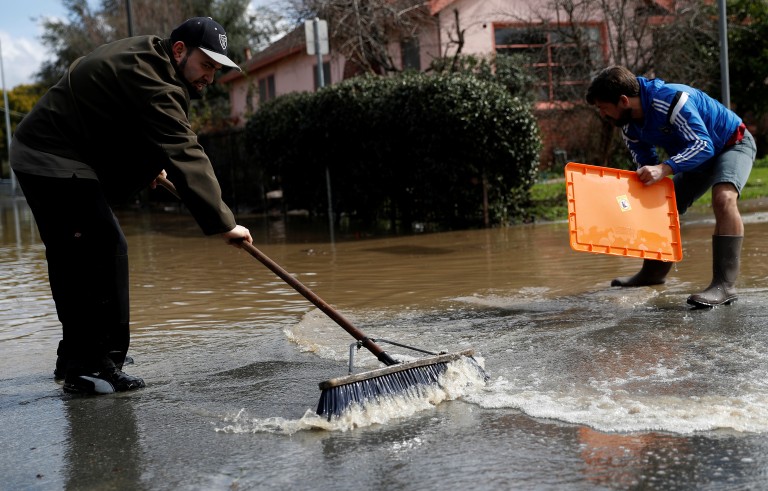HARI SREENIVASAN: Let's turn our focus out West to Northern California, where rain and flooding have wreaked havoc on a once-drought-stricken region.
Officials in San Jose ordered some 14,000 people to evacuate overnight. Floodwaters did stabilize today, but neighborhoods were inundated. Officials said they don't yet know when residents will be able to return to their homes.
We're now joined by the mayor of San Jose, Sam Liccardo.
Mayor Liccardo, I just want to ask. You have got 14,000 out for sure, another 20,000 encouraged to leave. All of them want this information that you can't give them yet, which is, when will they be able to go back home?
MAYOR SAM LICCARDO, San Jose, California: Yes, the important message is that we're not out of this yet.
Although the waters are receding, we know we have got other storms that are coming in. And it's not safe to go in many of these neighborhoods yet. We have got a lot of very contaminated water. And we don't want folks going in there if they're going to be in peril.
HARI SREENIVASAN: Do you have any estimate on how significant the damage is?
SAM LICCARDO: Not yet.
Right now, we're really just focused on making sure we're taking care of the families and their immediate needs. We are going to have an opportunity to get building inspectors in there to really look at the housing and make sure it's safe. And we will have a better sense in the days to come.
HARI SREENIVASAN: But why did it take so long to evacuate these folks? We were reporting on this in the East Coast. People knew that this storm was coming. You knew. You had the weather forecast.
Yet now we see reports that it was late last night where the police were pounding on doors and saying, hey, come on, it's too late, you have got to move.
SAM LICCARDO: Yes, it's fair to say we were preparing for a storm, but what really flooded these neighborhoods was the overpouring of a dam, Anderson Dam, which released a torrent of water that exceeded our 100-year flood estimate.
Essentially, the flood maps, the data that we were relying on wasn't preparing us for this. And so we are clearly learning some very hard lessons here, and we have got a lot to fix going forward.

HARI SREENIVASAN: Anderson Dam, which feeds that Coyote Creek area, some engineers say it could take nine weeks for them to bring it down to the safe levels at 68 percent, or whatever the capacity is of the reservoir. And right now, it's up at 100.
So, is there going to be a huge volume of water that floods through this creek and basically keeps this the status quo in San Jose and parts of other neighborhoods here?
SAM LICCARDO: Well, much depends on the rains that are to come.
We're expecting another storm this weekend. And we hope that obviously it won't be substantial, because we need to get some sun on this reservoir to get some of that water evaporated.
HARI SREENIVASAN: Has the city requested any sort of aid from the state or the federal government?
SAM LICCARDO: I had a conversation with the governor's office just a couple of hours ago.
We're working with them collaboratively. So far, we have been able to manage this on our own, really incredible work by a lot of firefighters, first-responders who are working many overtime shifts to safely evacuate hundreds of residents by boat, really a great testament to their hard work.
But we know we're probably going to need help in the weeks to come. And we're working now with the state to figure out how we can do that.
HARI SREENIVASAN: How many people do you still have in emergency shelters? And is that number decreasing?
SAM LICCARDO: We have more than 300 in shelters right now. The good news is really the overwhelming majority of the displaced residents were able to find help with friends or family members nearby.
So we're going to do everything we can to help folks who are displaced and see how we can help them get back on their feet. What's been a remarkable thing is to see how the community has reached out in various ways to help these families. Volunteers, a lot of contributions and donations we're seeing pouring in now.
It's a real testament to how this community is pulling together in tough times.
HARI SREENIVASAN: Is there anything else that the city of San Jose needs?
SAM LICCARDO: Well, certainly, we appreciate any contributions through our local community foundation to help these families get back on their feet.
But, more than anything, beyond a big bottle of Drano, we could use some sun. And we have got some sun today. And we hope that the good weather will persist as long as possible.
It's an odd thing to ask for in California, because we get 300 days of sun a year. And we have just endured years of drought. But we need more sun.
HARI SREENIVASAN: Yes.
All right, Mayor Sam Liccardo of San Jose, thanks so much.
SAM LICCARDO: Thank you.












